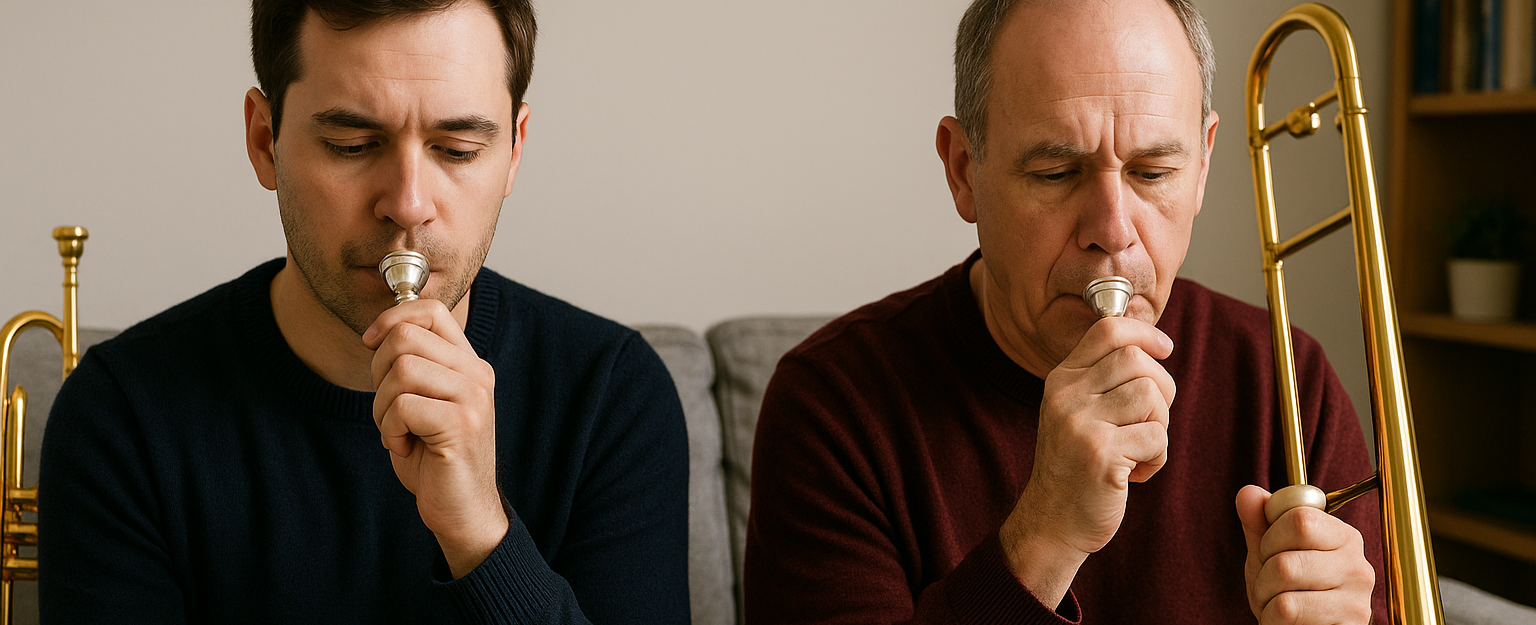Practicing the trumpet or trombone can be a challenge when you’re surrounded by sleeping kids, roommates, or thin apartment walls. Brass instruments are famously loud — and not everyone appreciates your 7 a.m. rendition of “Flight of the Bumblebee.” But there’s a quieter, equally powerful way to improve your playing: mouthpiece exercises.
Whether you’re trying to build strength, develop tone, or stay in shape when you can’t play full volume, mouthpiece practice is a game-changer. In this post, we’ll explore how trumpet and trombone players can use mouthpiece-only routines to improve embouchure control, air support, and pitch accuracy — without waking the neighborhood.
Why Practice with Just the Mouthpiece?
Before we jump into specific exercises, let’s clarify why mouthpiece practice is so beneficial:
- Low Volume: You can practice almost silently.
- Builds Strength: Isolating the embouchure muscles helps develop control and endurance.
- Improves Pitch Centering: It forces your ear to hear subtle pitch shifts.
- Focuses Air Support: You’ll learn to move air efficiently without relying on the instrument to do the work.
- Enhances Flexibility: Slurs and lip bends on the mouthpiece improve embouchure agility.
Best of all? You can do these anywhere — in your bedroom, car, or even on a hike.
Getting Started: A Few Quick Tips
- Use a Tuner or Drone: This will help you monitor pitch, especially since playing on the mouthpiece alone doesn’t give you valve or slide reference points.
- Keep a Mirror Handy: Watching your embouchure can help you spot tension or collapse.
- Start Simple: Don’t overcomplicate it. A few well-practiced routines are better than 20 rushed ones.
- Limit Practice Time: Mouthpiece buzzing is intense. Start with 5–10 minutes per session to avoid overworking the lips.
Warm-Up: Buzzing Basics
1. Free Buzz (No Mouthpiece)
Before touching the mouthpiece, try free buzzing — just your lips.
- Goal: Get the air moving and engage the lip muscles.
- How: Keep lips relaxed and blow air while creating a focused “buzz” sound.
- Duration: 3–5 minutes in short bursts (2–3 seconds each).
- Tip: Think “mmm” then gently blow — don’t force it.
2. Mouthpiece Sirens
Once warmed up, try sirens on the mouthpiece.
- Goal: Strengthen embouchure and build pitch awareness.
- How: Start on a low comfortable note and slowly glide up and down like a siren.
- Duration: 3–5 repetitions.
- Tip: Use smooth air; don’t jump between notes. Keep the sound steady and connected.
Core Exercises for Trumpet and Trombone
3. Long Tone Buzz
This is the bread and butter of mouthpiece practice.
- Goal: Improve tone stability and breath control.
- How: Pick a comfortable pitch and hold it steadily for 5–10 seconds.
- Duration: 5 minutes of various pitches.
- Tip: Use a tuner or drone and match pitch carefully. Focus on keeping the sound steady and full.
4. Pitch Matching with a Tuner or App
This sharpens your ears and pitch accuracy.
- Goal: Internalize pitch without relying on the instrument.
- How: Use a tuner or pitch generator app. Buzz to match the note exactly.
- Variation: Move between notes slowly (whole step slurs).
- Duration: 5–10 minutes.
- Tip: Sing the pitch first, then buzz it.
5. Lip Slurs on the Mouthpiece
Mouthpiece lip slurs are a great challenge.
- Goal: Increase lip flexibility and smooth air transitions.
- How: Start on one pitch and slur up or down by a whole step or more.
- Example: Buzz C → G → C → G → C (for trumpet) or Bb → F → Bb (for trombone).
- Duration: 5 minutes.
- Tip: Use slow, controlled air. No jerky movements.
Fun Additions to Keep It Engaging
6. Melodic Buzzing
Try buzzing simple tunes you know by heart.
- Goal: Build musicality, phrasing, and pitch memory.
- How: Start with easy tunes like “Mary Had a Little Lamb” or “Ode to Joy.”
- Duration: 5 minutes.
- Tip: Record yourself. You’ll be surprised how musical mouthpiece buzzing can sound when done well.
7. Call & Response (With Yourself)
- Goal: Train your ear and memory.
- How: Buzz a short phrase, pause, and try to repeat it exactly.
- Variation: Record the first part, then play it back and respond.
- Duration: As long as you’re having fun.
Bonus Tools for Quiet Practice
If you’d like to go even further without disturbing the peace, consider these:
- Buzzing Mutes: Insert into the bell; it reduces volume dramatically.
- Practice Mutes: Great for full horn playing at low volume.
- B.E.R.P. (Buzz Extension and Resistance Piece): Lets you buzz with mouthpiece while holding the horn.
- Silent Brass Systems (Yamaha): High-tech solution for quiet, full-range practice with headphones.
When & How Often Should You Buzz?
Here’s a sample 15–20 minute routine to keep your chops active even on quiet days:
| Time | Exercise |
|---|---|
| 2 min | Free buzz (lip warm-up) |
| 3 min | Sirens + lip slurs |
| 5 min | Long tones & pitch matching |
| 5 min | Melodic buzzing or slurs |
| 5 min | Fun: tunes, call & response |
Do this once or twice daily, especially on days when you can’t play your horn full out. If you’re on a trip or in a quiet space, it keeps your embouchure engaged without a full practice room setup.
Final Thoughts
Brass instruments may be loud, but your practice doesn’t have to be. Mouthpiece exercises offer a low-volume, high-value way to keep your skills sharp. Whether you’re a beginner or a pro, dedicating just 15 minutes a day to mouthpiece buzzing can transform your tone, flexibility, and confidence on the horn.
So the next time someone says, “It’s too loud to play that thing,” just smile — and start buzzing.





